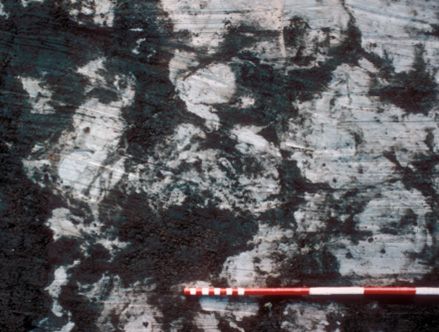
The environmental evidence from Goldcliff (Figure D) provides information (Bell et al. 2000) not only about the contemporary environment but how Iron Age people were using the wetland environment and landscape.

The Iron Age sites at Goldcliff lie in the intertidal area of the estuary, to the west of Goldcliff 'island', and are broadly contemporary with the wetland sites of Glastonbury and Meare in the Somerset Levels on the English side of the estuary. As at Goldcliff, exploitation of seasonal grazing is suggested but at Meare and Glastonbury a rich material culture also suggests seasonal meeting places for social interaction (Coles 1987; Coles and Minnit 1995). The waterlogged conditions mean that a range of evidence not usually found on dryland sites was preserved.
The Goldcliff sites consist of rectangular wooden buildings and trackways (Figure E). Pollen and stratigraphic evidence indicate the structures were constructed at a time when raised bog was gradually giving way to salt marsh. Most of the buildings and trackways were constructed during the later stages of carr woodland and the following reed swamp and salt marsh phases, but at Goldcliff West raised bog persisted up until occupation around the time of marine inundation.

Wood identification has demonstrated that in a number of the buildings local alder wood was used in their construction as well as a range of other species, including oak, elm, ash, hazel, field maple, birch, willow, alder buckthorn and hawthorn type. However, at Goldcliff West where the buildings were constructed on raised bog peat, alder was absent, suggesting different woodlands were exploited. There was no evidence for woodland management, such as coppicing, but the roundwood used in the buildings did suggest selection for size. In addition tree-ring studies indicated that wood used in the construction of the buildings and trackways was cut in both summer and winter. This may mean that wood was stockpiled for use during another season.
Evidence that the buildings were associated with animal grazing comes from footprint evidence (Figure F) and animal bones (Bell et al. 2000). Both the footprints and the animal bones suggest that cattle were the dominant animals present, although sheep/goat, horse and red deer were also recorded in the bone assemblage. The presence of mites, which indicate dung, and cattle lice demonstrated that the buildings housed cattle. From the size of the entrance to the building, calves may have been the most likely occupants. The presence of very young animals indicates that occupation was primarily in the spring and summer. This may indicate a pattern of locally transhumant land use. However, there is evidence that people were using the wetland landscape at other times of the year as well.

The wetlands were also used for other activities. The presence of a red deer skull as well as antler suggests that hunting was taking place rather than just the collection of shed antler. Hamilakis (2000) suggests hunting may have had a wider social significance for the agricultural society at Goldcliff than simply obtaining antler for tool making. Equally, the absence of fish bone is noticeable given the coastal location and, although this may be a result of fish processing or trading with sites inland, it may indicate sociological reasons why fish were not eaten. However, stable isotope analysis of a late Iron Age or Romano-British human skull from the Orb Steelworks, Newport (Bell 2000), indicates that individual had a diet comprising around 10-15% of marine protein. In addition a possible fishing structure at Cold Harbour Pill-2 (Neumann 2000) has been dated to the late Bronze Age or early Iron Age, but otherwise there is little evidence for fishing during the Iron Age from the Estuary.
Internet Archaeology is an open access journal based in the Department of Archaeology, University of York. Except where otherwise noted, content from this work may be used under the terms of the Creative Commons Attribution 3.0 (CC BY) Unported licence, which permits unrestricted use, distribution, and reproduction in any medium, provided that attribution to the author(s), the title of the work, the Internet Archaeology journal and the relevant URL/DOI are given.
Terms and Conditions | Legal Statements | Privacy Policy | Cookies Policy | Citing Internet Archaeology
Internet Archaeology content is preserved for the long term with the Archaeology Data Service. Help sustain and support open access publication by donating to our Open Access Archaeology Fund.